Pros
Cons
Introduction
Front
{{section_header}}{{section.name}}{{/section_header}}
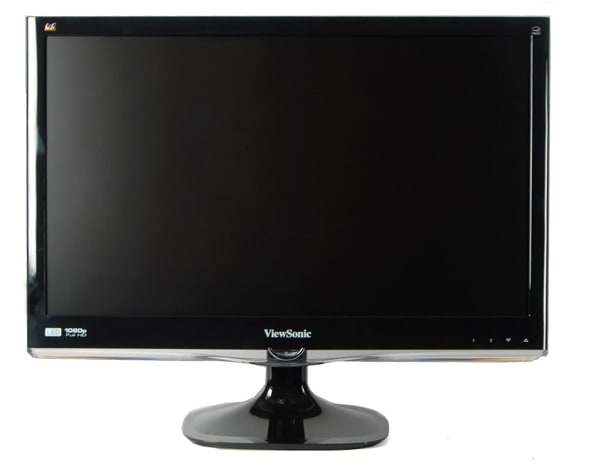
Back
{{section_header}}{{section.name}}{{/section_header}}

Sides
{{section_header}}{{section.name}}{{/section_header}}
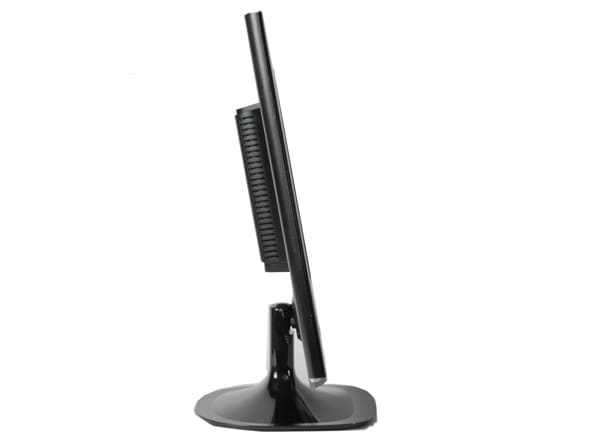
Size Comparisons
{{section_header}}{{section.name}}{{/section_header}}
In the Box
{{section_header}}{{section.name}}{{/section_header}}
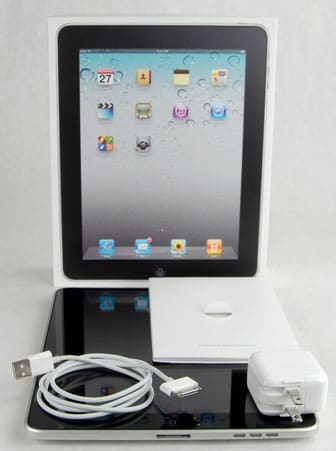
Amazon takes a minimalist approach to packaging the Kindle: as well as the device, all that you get is:
- USB/power cable
- 2 prong power adapter
No case, screen cleaner or other cables are included.
Handling
{{section_header}}{{section.name}}{{/section_header}}
The Kindle is a small, sleek device that fits well into the hand, with the thumb falling naturally onto the page control buttons on the side of the body. It is easy to hold in one hand or to prop on the knee while reading, and you don't need two hands to flip pages: the thumb can easily reach the page control buttons on the side of the body. These page control buttons are present on both sides of the body: a plus for the left-handed or those with limited mobility in the fingers.
At just over 0.3 inches thick, the Kindle is thin enough to fit into a coat pocket or small bag. It is light, too, at 8.5 oz for the WiFi model and 8.7 for the 3G connected one.
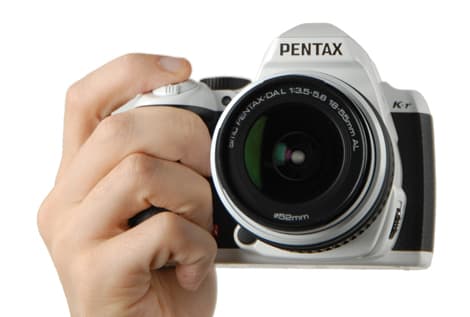
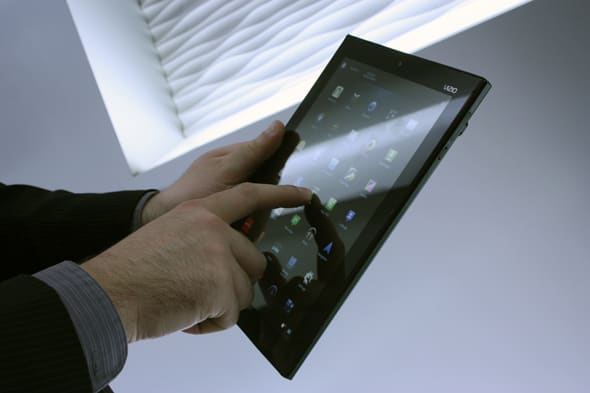
Screen
{{section_header}}{{section.name}}{{/section_header}}

Indoor & Outdoor Use
{{section_header}}{{section.name}}{{/section_header}}
The Kindle is at home reading books beside the pool as it is in the bedroom: the eInk display retains its smooth look in all lighting conditions. It does require some ambient light, though, so if you want to read under the covers, you'll need to bring a torch or buy a case with a reading light included.
Controls
{{section_header}}{{section.name}}{{/section_header}}
Many eBook readers eschew real buttons for on-screen ones, but the Kindle takes the opposite approach, featuring a number of buttons on its body. On the sides are two page control buttons for accessing the next (bottom button) and previous page (top). The next button is larger and is better placed for pressing with the thumb, which means that you can easily hold the Kindle in one hand and still control it, which is not possible with some of the larger readers.
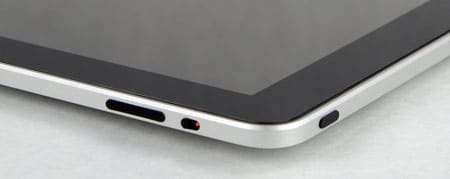
The controls on the top right side of the iPad body: volume, lock and power.
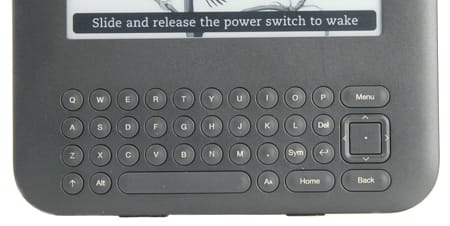
At the bottom of the front of the body is a small keyboard, with circular buttons for the keys. This is a rather awkward keyboard to use: the size and feel of the buttons means that using it is more of a hunt-and-peck experience rather than a touch typing one. It is adequate for typing the title of a book or author name (which is what it is designed for) but we wouldn't want to type our own novel on it. Two sliders on the bottom edge of the case control the WiFi or 3G connection and the power: the device is turned on by sliding and releasing the power switch.
Connectivity
{{section_header}}{{section.name}}{{/section_header}}
here). This approach not only keeps the cost down, but allows you to buy books while on vacation: ideal if an unforeseen flight delay leaves you stranded without reading material.

Here we see a Lightning dock in its natural habitat.
Battery Life
{{section_header}}{{section.name}}{{/section_header}}
We found that the Kindle had excellent battery life in our tests, with our eBook reading and audio playing tests both running for over 24 hours. We found that 24 hours of eBook page flipping only ran the battery down by 9 per cent, so we would estimate that a fully charged Kindle could keep reading a book continuously for over 11 days, which should satisfy even the most ardent reader. Although the Kindle was able to keep playing audio for the full 24 hours, this proved to be more of a drain on the battery, leaving about 71 per cent of the charge after the test was complete. So, we would estimate that the audio would keep playing for about 3 days of continuous use. As the Kindle only offers a paltry 3MB of storage space for audio, we doubt that the battery would be the limiting factor here.
Reading Books
{{section_header}}{{section.name}}{{/section_header}}
The Kindle is designed to be an eBook reader, and this shows: we found that it offered the best reading experience of any of the devices that we have tested so far. The eInk screen is easy on the eye and doesn't seem to cause the same sort of eye-strain that brighter LCD screen can, and looks great in all lighting conditions except total darkness. An LCD screen might be better if you read under the covers, but for every other situation, the Kindle eInk screen is superior. The device itself is also small and light enough to hold for long periods, and you can also hold the device and turn pages with one hand, thanks to the page forward and back buttons on both sides of the device.
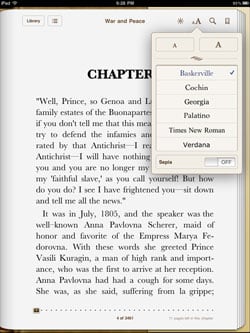
The iBooks program offers a range of controls for font and text size
Buying Books
{{section_header}}{{section.name}}{{/section_header}}
Buying books on the Kindle is simple to do: press the menu button, select Kindle Store, find the book you want and press Buy. This does require an internet connection, but we found that the process was simple and quick, usually finding the book in a few seconds.
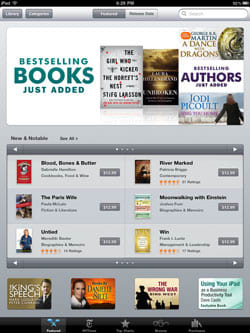
Books can be purchased on the iPad through the iTunes store
eBook Formats
{{section_header}}{{section.name}}{{/section_header}}
Calibre software can.
{{product.manufacturer_specs['eBook Formats Image']}}
One other feature is worthy of note here: the ability to email files directly to the Kindle. When you register the device, you set up an email address (in the form of [email protected]) and documents sent to this address will be converted by Amazon into Kindle format and wirelessly sent to the device. This conversion process supports a range of file formats, including Microsoft Word, PDF, HTML, GIF, JPEG and rich text format files. Amazon does charge a small fee (15 cents per megabyte) for this service, though. However, they do offer a free conversion service: just send it to the email address of [email protected] and it will be converted to Kindle format and sent back to you, ready to be transferred to the device via the USB connection.
Newspapers & Magazines
{{section_header}}{{section.name}}{{/section_header}}
Amazon offers subscriptions to a lot of magazines and newspapers through the Kindle, and these are delivered in the same way as books: over the internet connection of the device. On a Kindle 3G, the new issues are downloaded overnight, while the WiFi version downloads them whenever it is connected to the internet. The Kindle version of newspapers and magazines is converted from the printed version, with most of the photos removed and the text structured to fit better onto the screen. This means that you do not get the same feel and structure as the printed version.The various newspaper apps available for Android and iPad devices do a better job of reproducing the look and feel of a magazine, but the Kindle versions provide access to the content that is more suited to the limitations of the device.
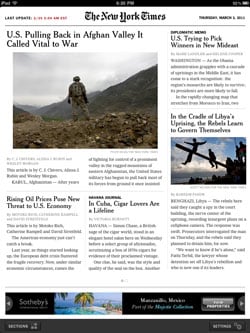
The New York Times is available on the iPad through their own app
eBook Battery Life
{{section_header}}{{section.name}}{{/section_header}}
{{product.manufacturer_specs['eBook Battery Life Image']}}
Music & Audio Controls
{{section_header}}{{section.name}}{{/section_header}}
The Kindle supports playing back music, and includes two small speakers on the back of the device and a headphone socket on the base. But it is clear that this was more of an afterthought than anything in the design process: the included audio player is extremely basic. It can play back MP3 files, but there is no support for organizing or sorting these files.
To play back MP3 files, you select the Play MP3 option from the Experimental menu. The Kindle then starts playing the first file it finds (in alphabetical order) in the music folder. You can skip to the next file by pressing F, or stop the music by pressing Alt-Space. And that's it: there are no controls for volume, for choosing a particular file or for finding a music file.
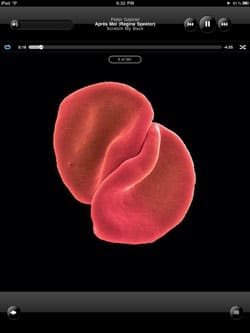
The iPod app shows the cover art while playing music
Music & Audio Management
{{section_header}}{{section.name}}{{/section_header}}
There are no audio management features on the Kindle: files are copied to the device by dragging and dropping them into the right folder, and the Kindle plays them in alphabetical order. There is no way to create playlists, to sort files into another order or to otherwise control the files on the device
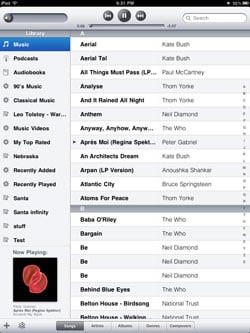
Audio files can be sorted by title, artist, album, genre or composer
Music & Audio Formats
Music & Audio Battery Life
{{section_header}}{{section.name}}{{/section_header}}
The Kindle does not offer any email features: apart from the basic web browser, there is no way to get or respond to email on the device.
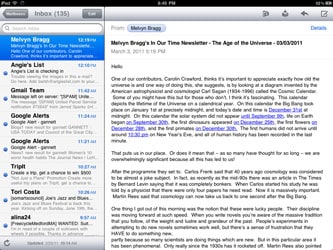
The iPad email app is basic, but adequate for most users
Web Browsing
{{section_header}}{{section.name}}{{/section_header}}
A very basic web browser is offered on the Kindle, but it is extremely basic and is not supported by Amazon. It can be found on the Experimental menu of the device, and it offers basic web browsing features. It does support bookmarks, but page navigation is awkward: as the device has no touch screen, you select a link using the small directional control and the select button. For a page with a lot of links on it, this translates into a lot of button mashing. We found that most pages rendered accurately, but the Kindle is slow to load the pages and the dark screen effect that the e-ink screen produces makes scrolling down pages somewhat disorientating. The Webkit browser does not support Flash, streaming audio or video, but it does support Javascript, so things like the Google Instant feature (which guesses at the word as you type and adds a drop-down list of possibilities) does work.
The experimental Kindle browser is adequate for very basic browsing tasks, so it would be fine for checking the news headlines or logging onto a web mail account to send a quick note. But it doesn't support the features needed for extended use, and the screen really is not designed for showing web pages.
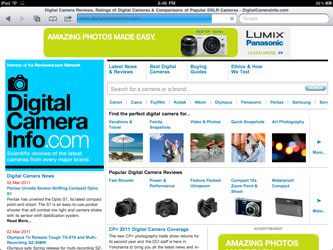
The iPad boasts a fully featured Safari web browser
Internet Apps
{{section_header}}{{section.name}}{{/section_header}}
The Kindle does offer support for downloadable games and other Apps, which Amazon calls Kindle Active Content. Only a very small selection of games and a few other programs are on offer, so so it is no surprise that Amazon does not seem to promote this aspect of the device much.

Other Internet Features
{{section_header}}{{section.name}}{{/section_header}}
{{product.manufacturer_specs['Other Internet Features Image']}}
Device & Specs
{{section_header}}{{section.name}}{{/section_header}}
It's the battle of champions: the iPad Vs the Kindle. The two favorites for the title of the top eBook reader or tablet are very different players, though, with the Kindle in the featherweight class (at just 8.5 ounces) and the iPad being a heavyweight, at just over 23 ounces. And the two devices are designed for rather different purposes, with the Kindle being purely an eBook reader, while the iPad is designed to replace a laptop by offering eBook, music, video and the ability to expand the functions by running apps purchased online. So, the choice between the two comes down to what you want. If you want to just read books on the road, the Kindle is the best pick. If you want to read books (except in direct sun), listen to music, watch videos, play games and browse the web, the iPad is the way to go.
Screen
{{section_header}}{{section.name}}{{/section_header}}
The two devices take different approaches when it comes to the screen. The iPad offers a big, bright LCD screen, while the Kindle has a smaller e-ink screen that has no backlight. The result is a different set of strengths and weaknesses, with the iPad offering a bigger screen that looks great indoors, but poor outside. The Kindle, however, offers a screen that is sharp and readable in everything from very dim light to direct tropical sun.
Battery
{{section_header}}{{section.name}}{{/section_header}}
Both devices include large batteries, but the iPad has an all-round shorter battery life.This is because the big LCD screen uses much more power than the small passive e-ink screen of the Kindle. In our tests reading an eBook, the iPad lasted just 5 hours and 37 minutes, while the Kindle lasted over 24 hours. If you are close to a power source, this may not be an issue, but the iPad is going to be a dead weight if you are going anywhere without a daily power source. The only exception to this was when playing back audio, where the iPad lasted much longer than the Kindle: we estimate that the iPad could keep playing audio for up to 16 days, while the Kindle could only manage about 3.
eReader
{{section_header}}{{section.name}}{{/section_header}}
Both devices do a very decent job of working as eBook readers, but with different approaches. The Kindle is like a paperback book (small, convenient, black and white) while the iPad is a hardback, coffee table edition (big, color, gorgeous looking, but somewhat difficult to carry around). And they work the same way as their book counterparts: the Kindle would be the one you take on vacation, while the iPad is the one you use at home.
Internet
{{section_header}}{{section.name}}{{/section_header}}
The iPad is the clear winner as a general internet device. Both devices come in different versions with different levels of Internet access, including those with 3G cellular modems and WiFi only devices (which are the versions we tested). They offer different levels of use for these connections, though, with the Kindle offering book downloads and an “experimental” (translation: very simple and unsupported) web browser. The iPad offers extensive email, browsing, and media streaming features that put the Internet at your fingertips, including support for Internet video and audio services such as Rdio, Pandora and Hulu.
Device & Specs
{{section_header}}{{section.name}}{{/section_header}}
The Amazon Kindle and Barnes & Noble Nook Color are two quite similar devices in many ways: both are small, sleek devices that make it easy to buy books and magazines to read on the go. But there are significant differences: the Kindle uses a passive eInk screen, while the Nook Color uses an LCD screen. Both types have their pros and cons (which we discuss below), but they make the two devices quite distinct.
Screen
{{section_header}}{{section.name}}{{/section_header}}
The two devices take different approaches when it comes to the screen. The Nook Color uses an LCD screen, while the Kindle has an e-ink screen that has no backlight. The result is a different set of strengths and weaknesses, with the Nook offering a slightly larger screen that looks great indoors, but fades outside, making it difficult to read in direct sunlight. The Kindle, however, offers a screen that is sharp and readable in everything from very dim light to direct tropical sun, so it is a better pick if you plan on sitting by the pool.
Battery
{{section_header}}{{section.name}}{{/section_header}}
Both devices include sizable batteries that can drive the device for quite a long time, but the Nook Color has an all-round shorter battery life.This is because the LCD screen uses more power than the passive e-ink screen of the Kindle, which has no backlight. In our tests reading an eBook, the Nook lasted just under 8 hours, while the Kindle lasted over 24 hours. If you are close to a power source, this may not be an issue, but the Nook Color is going to be a dead weight if you are going anywhere without easy access to power.
eReader
{{section_header}}{{section.name}}{{/section_header}}
The different screen types of the two devices make for quite a different reading experience. The passive eInk screen of the Kindle is more like reading a printed book, while the LCD screen of the Nook is more like a small laptop. The Nook Color screen offers color, which is a big plus for reading magazine and newspaper content, but the LCD screen fades in direct sunlight. The Kindle, however, looks great in any light from near darkness to direct tropical sun, so it is the better pick for a tropical vacation.
Internet
{{section_header}}{{section.name}}{{/section_header}}
Internet access is offered on both devices, but we would not recommend relying on either for anything more than occasional web browsing. Web pages look better on the LCD screen of the Nook Color than the eInk screen of the Kindle, but both are somewhat slow to browse the web and don't support Flash, Java or other forms of web content. Neither device supports email, either.
Device & Specs
{{section_header}}{{section.name}}{{/section_header}}
Physically, the two devices are similar, but the Kindle is a little smaller and sleeker. The Reader Daily also offers a touch screen interface in addition to the buttons, while the Kindle is controlled through the buttons only.
Screen
{{section_header}}{{section.name}}{{/section_header}}
E-Ink. There are some differences, though: the Sony adds a touch screen layer, which makes it look slightly less sharp. Otherwise, the two are identical, with the same overall performance and contrast.
Battery
{{section_header}}{{section.name}}{{/section_header}}
Both devices have battery power to spare, but the Kindle seems to have a slight edge, lasting longer in our tests for eBook reading and music playing. However, the battery on both devices is not likely to be a limiting factor unless you tend to spend weeks away from a power source.
eReader
{{section_header}}{{section.name}}{{/section_header}}
Both devices do an excellent job of showing eBooks, making it easy to read and buy books.
Internet
{{section_header}}{{section.name}}{{/section_header}}
Both devices can browse the web, but the experience isn’t stellar on either one. The eInk displays we’ve seen so far have all been slow and clunky on the internet, and pale in comparison to the experience you’d get from the average smartphone.
Conclusion
Performance
Amazon built the Kindle as a gateway into their online bookstore, and it servers that purpose well. We found in our tests that it performed extremely well, with a sharp, clear screen that looks great in any light and easy and quick access to a huge range of books to buy. But don't confuse the Kindle with an open device that can access a number of online stores: it is owned body and soul by Amazon, and there is no easy way to get content from other stores onto the device. It can load PDFs and books without copy protection, though, and Amazon provides free direct access to a huge range of out of copyright books through their online store. This means that you could buy a Kindle and stock it with classic books to read on vacation without paying a dime.
Screen Performance
The eInk screen of the Kindle does an excellent job of displaying eBooks: the text is sharp and clear, and the screen looks great in any lighting from near darkness to direct tropical sun. And this puts it light years ahead of devices that use LCD screens, like the iPad and Barnes & Noble Nook Color, that look pale and unreadable in direct sunlight. If you are heading for the beach this summer, the Kindle is the eBook reader to pack.
Battery Life
solar charger and would never need to worry about finding a power socket halfway around Mt Kailash.
Ereader:
The Kindle is the device to beat as an eBook reader: it is small, sleek and has an excellent screen. It wears its stripes as an Amazon project rather loudly, though: the only online store that it can access is the Amazon one, and there is no way to get books purchased through other stores (such as Apples iBooks, Barnes & Noble or Kobo) onto the device. It can load non-copy protected books and PDF files, though, and Amazon provides a way to send PDF files direct to the device through email. Should you need to urgently review a work document while you are away from your laptop, this could prove to be a useful feature.
Audio & Video:
If there is one area where the Kindle really fails to deliver, it is this. It does not support playing back video, and the music playback is so poorly implemented as to be practically useless. The only thing that it might be good for is to use to listen to audio books, as it lacks the features (such as sorting, playlists, etc) that even the cheapest digital music device offer.
Email & Web Browsing:
Internet access is another area where the Kindle has only marginal performance: the experimental web browser that it offers has a reasonable feature set, but browsing web pages on the slowly updating eInk screen is a painful experience. It might be fine for checking the news headlines, but it isn't good enough to make the Kindle an Internet device that you could rely on.
Meet the tester
Richard Baguley is a veteran writer who has written about technology ranging from Alphabet to Zip file utilities. He has contributed to pretty much every major tech publication, including Amiga Format Magazine, PC World, Wired, CNET, Toms Guide, Forbes, and many others. He lives in the Boston metro area with his wife, dog, and an indeterminate number of cats.
Checking our work.
Our team is here to help you buy the best stuff and love what you own. Our writers, editors, and experts obsess over the products we cover to make sure you're confident and satisfied. Have a different opinion about something we recommend? Email us and we'll compare notes.
Shoot us an email